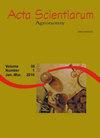人口密度和空间布局优化下甜菜-豇豆间作的生物农业经济效益
IF 1.2
4区 农林科学
Q3 AGRONOMY
引用次数: 1
摘要
在半干旱环境中,甜菜和豇豆的种植业面临的巨大挑战之一是保持其产量。在这种情况下,本工作的目的是通过优化人口密度和组成作物的空间安排来评估甜菜-豇豆的关联是否存在生物农业经济回报。试验采用随机完全区组设计,处理按4 × 3因子方案安排,有4个重复。第一个因素是豇豆种群密度(单作物推荐种群的100、80、60和40%)与甜菜的关联,第二个因素是甜菜(B)行与豇豆(C)行交替形成的空间排列(2:2、3:3和4:4)。竞争农艺指标为侵略性、竞争比、土地等效比、实际产量损失、间作优势和生产效率指数。评估的经济指标是毛收入、净收入、回报率和利润率。通过对各组成作物的生产要素、种群密度和空间安排的合理管理,可以获得较高的农业经济效益。当豇豆和甜菜种群密度分别为RPSC的40%和100%时,豇豆和甜菜的农业经济效益最大。甜菜与豇豆2∶2的空间布局具有最佳的生产性能和较高的经济效益指标。豇豆为优势作物,甜菜为优势作物。本文章由计算机程序翻译,如有差异,请以英文原文为准。
Bio-agroeconomic returns in beet-cowpea intercropping by optimization of population densities and spatial arrangements
One of the great challenges of the beet and cowpea cultivation in crop association is to maintain their productivity as that of their sole counterparts in semi-arid environment. In this context, the objective of this work is to assess whether there is bio-agroeconomic return in associations of beet-cowpea by the optimization of population densities and spatial arrangements of the component crops. Experiments were performed in randomised complete block designs with treatments arranged in a 4 × 3 factorial scheme, with four replications. The first factor was the population densities of cowpea (100, 80, 60, and 40% of the recommended population in single crop - RPSC) in association with beet, and the second factor was the spatial arrangements (2:2, 3:3, and 4:4), formed by beet (B) rows alternating with cowpea (C) rows. The competition and agronomic indices evaluated were aggressiveness, competitive ratio, land equivalent ratio, actual yield loss, intercropping advantage and the productive efficiency index. The economic indicators evaluated were gross income, net income, rate of return and profit margin. High agro-economic efficiency can be obtained in the cultivation of beet and cowpea intercropping when well-managing the factors of production, population densities and spatial arrangement of the component crops. The greatest agro-economic return of the cowpea and beet intercropping was obtained in the population densities of 40 and 100% of RPSC for cowpea and beet, respectively. The 2:2 spatial arrangement between beet and cowpea crops was the one with the best productive performance and higher indicators of economic return. The cowpea was the dominant crop while the beet was dominated.
求助全文
通过发布文献求助,成功后即可免费获取论文全文。
去求助
来源期刊

Acta Scientiarum. Agronomy.
Agricultural and Biological Sciences-Agronomy and Crop Science
CiteScore
2.40
自引率
0.00%
发文量
45
审稿时长
>12 weeks
期刊介绍:
The journal publishes original articles in all areas of Agronomy, including soil sciences, agricultural entomology, soil fertility and manuring, soil physics, physiology of cultivated plants, phytopathology, phyto-health, phytotechny, genesis, morphology and soil classification, management and conservation of soil, integrated management of plant pests, vegetal improvement, agricultural microbiology, agricultural parasitology, production and processing of seeds.
 求助内容:
求助内容: 应助结果提醒方式:
应助结果提醒方式:


